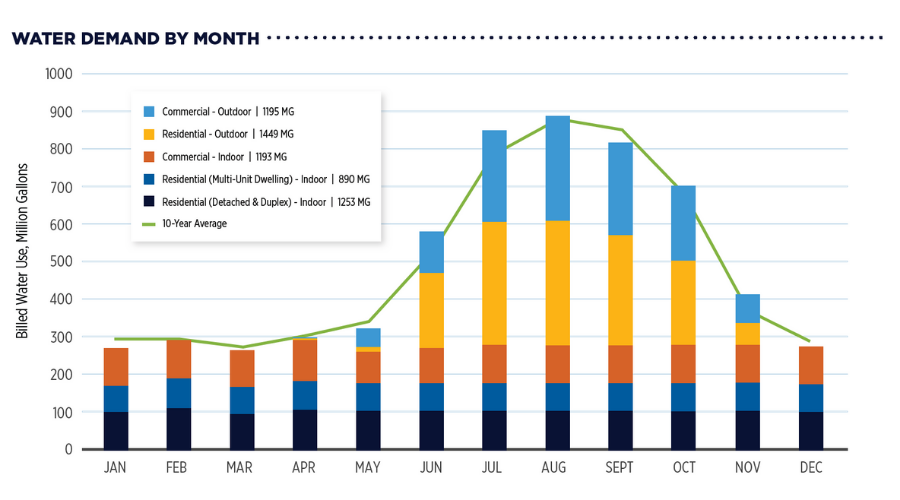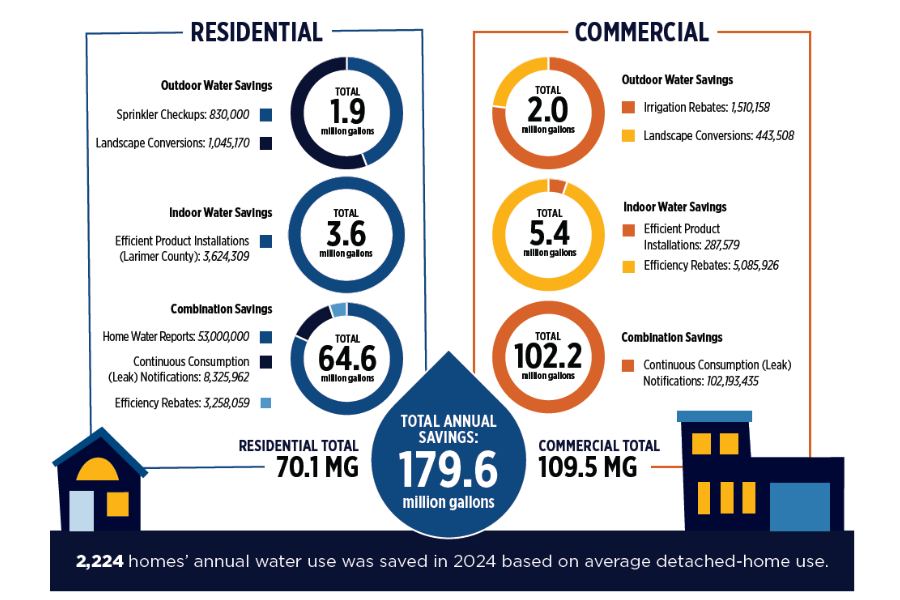2024 Water Conservation Annual Report#
Fort Collins Utilities has a strong commitment to ensuring the efficient and responsible use of our natural resources. Our Water Conservation Program started in 1977 and we continue to innovate how we help the community use water wisely.
135 GPCD | Gallons per Capita per Day (GPCD) is a way to measure how much water, on average, each person uses per day. It includes all water use—at home, at work, and in businesses—divided by the number of people who live here. We’re progressing toward our current goal of lowering use to 130 GPCD by 2030.
2024 By The Numbers#
In 2024, water-saving actions conserved approximately 70 million gallons through residential programs and 110 million gallons through commercial efforts—totaling 180 million gallons, or about 2.5% of the City’s total treated water for the year. That’s equivalent to the average annual water use of 2,224 detached homes in Fort Collins.
- Rebated 876 high-efficiency rotary nozzles saving over 1.3 million gallons of water annually.
- Sent 12,853 leak alerts via MyWater, helping customers fix leaks sooner and savings an estimated 111 million gallons of water.
- Reviewed 276 irrigation designs, ensuring new commercial landscapes meet high-efficiency irrigation codes.
- Welcomed 830 attendees to EcoFest/Xeriscape Garden Party and helped 3,300 plants find new owners at the NoCo Native Plant Swap.
- Provided 600 showerheads and 1,000 sink aerators at a large multi-unit residential complex saving 3 million gallons of water. Customers received the equipment and installation for free through Efficiency Works.
- Completed 77 residential and commercial Xeriscape Incentive Program (XIP) projects.
- Since 2016, 581 XIP participants have renovated 33 acres of Fort Collins landscape to reduce their total annual outdoor water use by 8.6 MG.
- Updated City Code to limit landscapes on new commercial and multi-unit residential developments to no more than an average 11 gallons per square foot of water per year, which is 25% less than prior code requirements.
- Engaged with the community and stakeholders to gather input from over 5,000 interactions, helping shape the next Water Efficiency Plan. The plan will establish new goals for water use across the City and community, along with the strategies to achieve them. Adoption is anticipated in 2025.
2024 WATER DEMAND BY MONTH#

ESTIMATED WATER SAVINGS OF PROGRAMS AND SERVICES#

Factors That Influence Water Use Include#
- Conservation: Actions such as taking shorter showers, monitoring your outdoor water use, turning off the faucet while brushing your teeth and other behaviors add up and can make a collective difference.
- Efficient Fixtures/Appliances/Landscapes: Homes and businesses that have water-efficient appliances, fixtures, irrigation, and technologies use less water every time someone flushes, washes, showers, or waters their landscape.
- Leaks: The average household in the US wastes 10,000 gallons of water due to leaks every year, which is about 12% of the total average annual household water use. 10% of homes have leaks that waste 90 gallons or more per day.
- Population: More people means more water use. Total residential and commercial water use all increase with a growing population.
- Land Development Patterns and Urban Design: Less dense developments with more landscaped areas require more outdoor water use to maintain. Landscape types that are not regionally adapted or native to our area, such as turf grasses and others, require more water than nature provides.
Did You Know?
Closing windows during summer days keeps cool air inside (while your AC is running).
Timers or sensors can help save money on outdoor lighting.
Watering only when grass turns a dull, grey-green color and footprints remain helps save water and money.